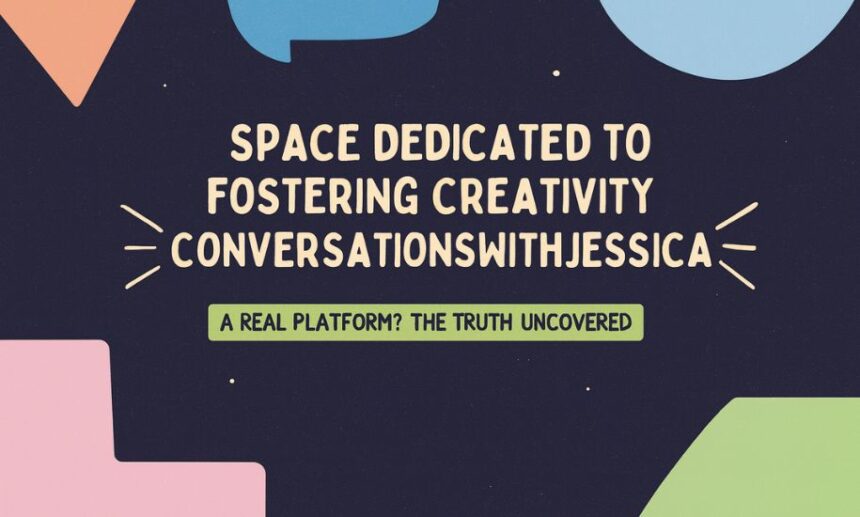In a world where innovation drives progress and imagination fuels solutions, the idea of building a space dedicated to fostering creativity conversationswithjessica has become more than just a concept—it’s a movement. Creativity is no longer seen as an abstract luxury; it is a necessity for personal growth, education, business innovation, and community development.
Through platforms like ConversationsWithJessica, we are reminded of the importance of creating intentional spaces—both physical and mental—that nurture ideas, encourage collaboration, and embrace the freedom to explore new possibilities. But what exactly does fostering creativity mean, and how can one create the right space for it to thrive? Let’s dive deeper.
What Is the Meaning of Fostering Creativity?
The phrase “fostering creativity” can be understood as deliberately creating the conditions that allow new, imaginative, and practical ideas to emerge. This doesn’t happen by chance—it requires care, structure, and intention.
Fostering creativity means:
-
Encouraging curiosity and experimentation. Curiosity leads to questioning the norm and discovering alternatives.
-
Accepting failure as part of learning. Every failed attempt is a stepping stone toward breakthrough.
-
Promoting freedom and flexibility. When restrictions are minimized, people dare to think differently.
-
Valuing diverse perspectives. Different cultural, social, and professional experiences inspire new ideas.
In education, fostering creativity strengthens problem-solving skills. In business, it drives innovation and competitive advantage. On a personal level, it unlocks expression, well-being, and growth.
Thus, the meaning of fostering creativity is about designing environments—emotional, physical, and cultural—that encourage imagination, resilience, and discovery.
ConversationsWithJessica: A Living Example
ConversationsWithJessica is an inspiring model of a space dedicated to fostering creativity conversationswithjessica. It is not limited to physical walls but extends into dialogue-driven communities and collaborative networks that support creators.
What makes it unique?
-
Guided conversations: Discussions help participants think differently and overcome creative blocks.
-
Collaborative spirit: Artists, writers, entrepreneurs, and everyday thinkers come together to share experiences.
-
Low-pressure environment: It focuses on exploration rather than perfection.
-
Community projects: From podcasts to group art initiatives, it nurtures collective imagination.
This platform demonstrates that creativity thrives not only in studios or offices but also in shared dialogues and digital spaces.
How to Create Space for Creativity
If you’re inspired by ConversationsWithJessica, here’s how to design your own space dedicated to fostering creativity conversationswithjessica.
1. Shape the Physical Environment
-
Zones for different activities: Quiet corners for deep thinking, open areas for collaboration, and playful spaces for brainstorming.
-
Light and nature: Use natural light and add plants to refresh energy and reduce stress.
-
Flexible setup: Movable furniture, writable walls, and versatile layouts help adapt to creative needs.
-
Declutter and curate: Remove unnecessary distractions while displaying inspiring visuals, books, or tools.
-
Color and texture: Warm colors and creative textures boost energy and mood.
A thoughtfully designed environment acts as a silent collaborator in your creative journey.
2. Build the Mental and Emotional Space
-
Protect creative time. Treat it as sacred—block it off like any other appointment.
-
Start with rituals. Freewriting, doodling, or meditation prepares your brain for fresh thinking.
-
Embrace a growth mindset. Shift focus from perfect results to the joy of exploration.
-
Make room for playfulness. Laughter, curiosity, and childlike wonder fuel creativity.
Creativity is not only about tools or rooms—it’s also about the mental landscape you cultivate.
3. Foster a Cultural Space for Creativity
-
Encourage open sharing. Conversations spark ideas, just like those at ConversationsWithJessica.
-
Remove fear of failure. When mistakes are seen as learning opportunities, creativity blossoms.
-
Celebrate all wins. Small achievements build momentum and confidence.
-
Offer support and resources. Provide access to tools, workshops, and collaborative communities.
When culture values creativity, everyone feels empowered to contribute.
Examples of Creative Spaces in Action
-
Corporate Innovation Labs: Modern businesses design spaces with movable walls, brainstorming pods, and creative tools to push innovation.
-
School Maker Spaces: Students experiment with robotics, coding, and design in labs dedicated to learning by doing.
-
Digital Communities: Online platforms like ConversationsWithJessica serve as virtual studios for idea-sharing.
-
Personal Studios: Whether it’s a writing desk, an art corner, or a recording nook, personal sanctuaries encourage consistent creativity.
Each of these illustrates the same principle: when a space is designed for creativity, ideas flourish.
Benefits of a Space Dedicated to Fostering Creativity ConversationsWithJessica
-
Better problem-solving: Encourages out-of-the-box solutions.
-
Improved well-being: Creative activity reduces stress and enhances happiness.
-
Stronger collaboration: Shared spaces unite people and ideas.
-
Sustained innovation: Both individuals and organizations benefit from constant idea flow.
Such spaces aren’t just beneficial—they’re transformative.
Practical Steps to Start Your Own Space
-
Choose your medium. Decide whether your creativity leans toward writing, design, art, or innovation.
-
Select a location. It could be a corner in your home, a coworking space, or even a digital platform.
-
Gather essentials. Keep your most-used tools within reach.
-
Personalize the area. Add objects, colors, and textures that inspire you.
-
Set creative routines. Dedicate time weekly to creative exploration.
-
Engage with communities. Share your process with groups like ConversationsWithJessica.
Even small steps can create profound change in your creative output.
Why This Matters Now
In a time when automation and efficiency dominate, the human ability to create something new is our greatest advantage. Creativity is not limited to artists; it’s vital for entrepreneurs, students, educators, and leaders.
Spaces like ConversationsWithJessica prove that when creativity is intentionally nurtured, it sparks innovation, resilience, and joy that ripple far beyond the individual.
Conclusion
A space dedicated to fostering creativity conversationswithjessica is not simply a room—it is a mindset, a community, and a movement. By learning what it means to foster creativity and understanding how to create space for creativity, we can all unlock new dimensions of imagination in our lives.
Whether it’s through a corner in your home, an innovation hub at work, or an inspiring online community, the act of carving out creative space can transform both personal growth and collective progress.
And for more insights, stories, and ideas that celebrate creativity and lifestyle, don’t forget to check out Tumblr Magazine, where conversations about imagination continue to thrive.







